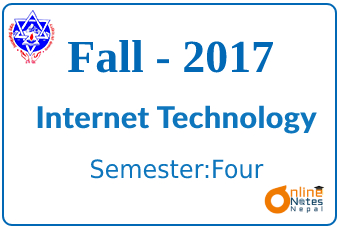Published by: sadikshya
Published date: 26 Jun 2021

This is the question set Web Technology I Fall 2016, which was taken by the Pokhara University.
| Level: Bachelor | Semester –Fall | Year: 2017 |
| Program: BCIS | Full Marks: 100 | |
| Course: Web Technology I | Pass Marks: 45 | |
| Time: 3hrs. | ||
Attempt all the questions.
1. a) What is an HTML document? How comment is added on HTML? Create a basic HTML file using proper tags.
b) Why table is used in HTML? Write an HTML code to display the following table.
PICTURE
2. a) What is client-side and server-side image map? Why Frame is needed on HTML pages explain with an example.
b) What are the trademark and ownership issues on web applications? Why appropriate layout is required on page designing explain.
3. a) What is HTML POST and HTML GET ? Write an HTML code to take (Name, Address, Email, Gender, About) from the user using the form.
b) What do you mean by CSS? Explain along with its type.
4. a) Why tag is used in HTML.Explain the hyperlink and list used in HTML along with its type.
b) Differentiate between Static and Dynamic Websites. Explain why it is necessary to make websites dynamic and how can we make them dynamic?
5. a) What is XML? Explain Internal and External DTD with examples.
b) What do you mean by Well-formed XML?
“All valid XML is well-formed but all well-formed XML is not valid”. Give a reason to justify this statement with an example.
6. a) What do you mean by Web Server? Explain protocols use on the internet and Domain hierarchy in detail.
b) What is client-side scripting? Write a JS code to validate a form using an appropriate function for following fields input from user using the form.
i) Name (Not empty)
ii) Password (Not empty & Min 8 Characters)
iii) Phone (Not empty & Min 7 Characters)
iv) Email (Match the email format)
v) About (Not Empty)
7. Write short notes on any two:
a) Client Pull and Server Push.
b) URL encoding and decoding.
c) HTTP requests and responses.